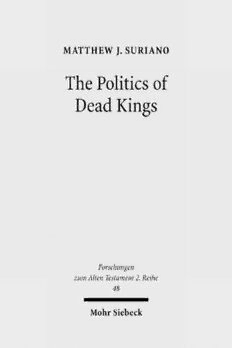
The Politics of Dead Kings: Dynastic Ancestors in the Book of Kings and Ancient Israel PDF
Preview The Politics of Dead Kings: Dynastic Ancestors in the Book of Kings and Ancient Israel
Forschungen zum Alten Testament 2.Reihe Edited by Bernd Janowski (Tübingen) · Mark S.Smith (New York) Hermann Spieckermann (Göttingen) 48 Matthew J.Suriano The Politics of Dead Kings Dynastic Ancestors in the Book of Kings and Ancient Israel Mohr Siebeck Matthew J.Suriano,BA in History from University of Illinois,Urbana-Champaign; MA in Ancient History from Jerusalem University College,MA and PhD in Hebrew Bible and Northwest Semitics from University of California,Los Angeles;has taught at University of Southern California’s School of Religion and was a Lecturer in Near Eastern Languages and Cultures at UCLA with a visiting faculty appointment in the Department of Religious Studies at the University of California,Santa Barbara;cur- rently Visiting Lecturer in Hebrew Bible and Ancient Judaism in the Department of Religious Studies at Indiana University,Bloomington. e-ISBN PDF 978-3-16-151146-2 ISBN 978-3-16-150473-0 ISSN 1611-4914 (Forschungen zum Alten Testament,2.Reihe) Die Deutsche Nationalbibliothek lists this publication in the Deutsche Nationalbiblio- graphie;detailed bibliographic data are available on the Internet at http://dnb.d-nb.de. © 2010 by Mohr Siebeck,Tübingen,Germany. This book may not be reproduced,in whole or in part,in any form (beyond that permitted by copyright law) without the publisher’s written permission.This applies particularly to reproductions,translations,microfilms and storage and processing in electronic systems. The book was printed by Laupp & Göbel in Nehren on non-aging paper and bound by Buchbinderei Nädele in Nehren. Printed in Germany. For Lisa, for Alexander Preface This work originated as a doctoral dissertation submitted to the Department of Near Eastern Languages and Cultures at the University of California, Los Angeles. I am indebted to my advisor and friend, William M. Schniedewind, who supervised and guided this work. I would also like to recognize and thank all members of the committee, from its inception to its completion, beginning with Aaron Burke, Sarah Morris, and including Robert Englund and Elizabeth Carter. Part of my dissertation research was conducted at the Albright Institute of Archaeological Research in Jerusalem while I was the annual George A. Barton Fellow, and I would like to ac- knowledge and thank the institute’s director, Seymour (Sy) Gitin, for his support during this time. In my effort to give adequate acknowledgement, I must include a bit of the book’s history. My interest in the subject of this study goes back to the beginning of my graduate education in Jerusalem and it is a credit to two of my earliest mentors, Anson Rainey and Gabriel Barkay. Gaby stoked my interest into the broader issues of death and bur- ial in ancient Israel and Anson made me aware of the issues involved in the sources. The present book represents a revised, re-organized and augmented ver- sion of the dissertation. This revision includes the addition of Chapter Three as well as revised material in what has become Chapter Six. In the latter case, much of the research from the original chapter will appear as an article in the journal Aula Orientalis. I would like to thank Bernd Ja- nowski, Mark S. Smith, and Hermann Spieckermann, the editors of the se- ries Forschungen zum Alten Testament II, as well as Henning Ziebritzki, the Editorial Director of Theology and Jewish Studies at Mohr Siebeck, for accepting this work. In particular, I would like to express a sincere debt of gratitude to Mark S. Smith for his insight and invaluable comments during the manuscript’s continued phase of research, post-dissertation. My grati- tude also extends to Herbert Niehr for generously sharing articles that I had difficulty accessing. Likewise, I want to thank Sara Brumfield for her care- ful reading and checking of sources, and to Tanja Mix at Mohr Siebeck for her enduring editorial assistance. VIII Preface Finally, I would like to thank my wife Lisa and my family for their pa- tient yet enthusiastic support, which remained constant throughout each stage of the book’s development. Matthew J. Suriano Bloomington, Indiana Table of Contents Preface...................................................................................................VII List of Figures.......................................................................................XIII Abbreviations........................................................................................XIV Chapter One: The Royal Epilogues and the Politics of Dead Kings.................................................................................................1 1.2. Research Objectives............................................................................3 1.2.1. Interpretive Model...........................................................................7 1.2.1.1. Theoretical Precepts...........................................................8 1.2.1.2. Transition Rituals and Funerary Rites...............................13 1.2.2. Theory, Artifact and Text: A Synthesis..........................................16 1.3. Conclusion........................................................................................21 Chapter Two: The Formulaic Epilogues in the Book of King...22 2.1. Introduction.......................................................................................22 2.2. History of Research into the Epilogue Formulary.............................23 2.2.1. The Study of the Deuteronomistic History......................................24 2.2.2. The Epilogue Formulae: A Brief History of Research....................26 2.3. To Be Gathered to/Lie with the Ancestors.........................................32 2.3.1. Interpreting the Phrase: A History of Scholarship...........................34 2.3.1.1. The Biblical Interpretation..............................................35 2.3.1.2. The Archaeological Interpretation...................................36 2.3.1.3. The Interpretative Problems............................................40 2.3.2. A New Approach............................................................................41 2.3.2.1. The Social Context...........................................................42 2.3.2.2. The Biblical Context........................................................42 2.3.2.3. The Literary Order...........................................................42 2.3.3. The Inheritance Implications of “Gathered to His People”.............46 2.3.3.1. The Death of Jacob..........................................................46
